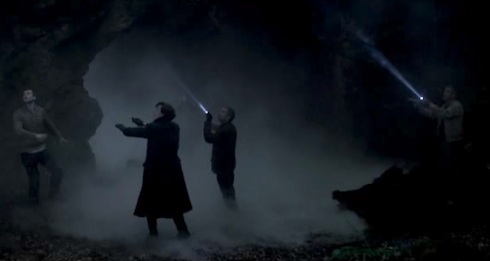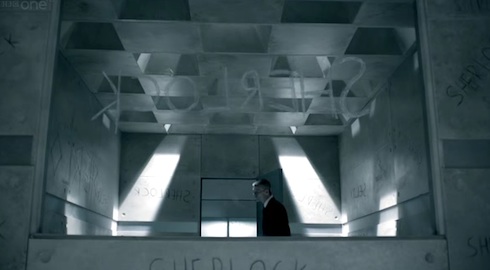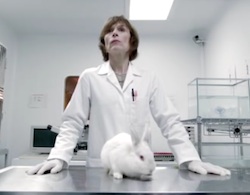Hot on the high-heels of Irene Adler’s incursion into Baker Street, PBS has aired the second episode of the second season of Sherlock. Like the previous episode, this too aims to be a straight-forward contemporary adaptation of a famous Arthur Conan Doyle Sherlock Holmes plot. The novella “The Hound of the Baskervilles” is arguably the most famous and enduring Sherlock Holmes adventure of them all probably owing to the fact that, as Doyle said, the tale is a “real creeper.” But with inclusion of seemingly more hounds, does the Mark Gatiss-penned “The Hounds of Baskerville” live up to its chilling literary forbearer? Read on to find out!
Big Spoilers!
Because Baskerville is now a military installation instead of a family name, the role of young Henry Baskerville has been transmuted into Henry Knight (Russell Tovey), a man who believes he witnessed his father’s murder at the paws and fangs of a ferocious and monstrous hound. The audience is taken inside Henry’s mind and experiences his trauma first hand. But now he’s a grown man and he’s seen the hound again, this time almost certainly for real.
After the credit sequence we’re taken back to 221b Baker Street where a grumpy Sherlock enters the flat covered in blood and wielding a large harpoon. This is a reference to the later-era Holmes story “Black Peter” and as in that story; Sherlock has just obtained evidence for a case by stabbing the carcass of a pig with said harpoon. Unfortunately, he now has no cases save for the pleas from a child to help her find her missing rabbit, Bluebell. It seems Bluebell vanished in the middle of the night after glowing like a magical faerie! Sherlock is enraged and begins tearing the sitting room apart for cigarettes, which John and Mrs. Hudson steadfastly deny him. But they’re soon interrupted by the arrival of Henry Knight.
Henry has recently been on a television documentary that details the various conspiracy theories surrounding the military installation of Baskerville. Everything from genetic experiments on animals to projects involving chemical warfare are suspected within the compound, and Henry believes his father was murdered by such a genetic experiment. Sherlock initially dismisses the notion of a monster clone dog as rubbish, but there’s something about the way Henry says “monstrous hound” that makes Sherlock take the case. Soon he and John are in route to Dartmoor to investigate the Baskerville base.
Sherlock has long ago swiped an extra government ID from his brother, Mycroft, which they use to gain entry to Baskerville, and with a little extra realism — provided by John Watson’s military background — the pair are soon marching around like they own the place. Indeed, genetic experiments on animals are taking place here and the guard who is escorting Sherlock and John seems to confirm that even chemical warfare is not out of the question. Sherlock confronts one particular scientist named Dr. Stapleton, a woman who works with rabbits. Oh, snap! There is a connection between the disappearances of the little girl’s rabbit, Bluebell, as it appears it was her mother here who accidentally caused it to glow in the dark with various experiments. (This little touch is a good call back to the beginning of the episode, but in it of itself a reference to the original Baskervilles story insofar as phosphorus was used to make the Hound “glow” in a ghostly way.)
Sherlock and John also meet Dr. Frankland who also knows Henry Knight and apparently knew his father. In fact, when security revokes the stolen ID card, and the guards are closing in to apprehend Holmes and Watson, Frankland comes to their aid by perpetuating the lie that Sherlock is indeed and in fact Mycroft. As they walk away from the guards unfettered, Dr. Frankland says he noticed Sherlock from the pictures in the newspapers, though he “hardly recognized him without his hat.” This is a nice jab at the general misconception of the character Sherlock Holmes always being clad in that hat. In any case, though welcome, Frankland’s assistance of our duo is a little strange.
Back at Henry’s home, Sherlock decides it’s time to take him out on the moor and wait for “something to attack him.” Out in the dark with flashlights, walking through the fog, Sherlock and Henry are briefly separated from John, who sees a light in the distance that he thinks is Morse code. Meanwhile, Sherlock and Henry are confronted with the monstrous hound. Notably, the audience doesn’t see the hound, but both Henry and shockingly, Sherlock, are horrified beyond words. Sherlock briefly lies to Henry about having not seen the hound, but later confesses to John he did see it and has been rattled to the core. Sherlock is genuinely freaking out and nearly cannot believe his eyes. Here, he utters his famous maxim of “if you eliminate the impossible whatever remains however improbable must be the truth,” even if the truth is an impossible hound.
Henry Knight has a shrink though, and Sherlock sends John to butter her up for information in the guise of “chatting her up.” However, the faux-date/information gathering session is mercilessly crashed by Dr. Frankland who spills the beans on John’s identity as assisting in an investigation. By this time, Detective Inspector Lestrade of Scotland Yard has also arrived from London, claiming to simply be on vacation. There’s a good bit here where John calls Lestrade by his first name, Greg, though Sherlock thinks it’s a code name. In the original stories, Lestrade was never given a full first name, only the initial G. Fun. But with Lestrade in Dartmoor, the players are present in a similar way to the original story.
Sherlock needs more answers, so he and John return to Baskerville, this time managing to clear out nearly all the military personal for a full inspection of their own. In a harrowing and nerve-wracking scene, John is seemingly cornered by the hound inside of a laboratory. We never see the beast, and soon Sherlock comes to his recuse. With the aid of Dr. Stapleton, Holmes attempts to test a theory: hallucinogenic drugs have been put into various supplies of sugar, which are making people believe they have seen the hound. This proves to be scientifically inaccurate, though Sherlock still believes drugs to be the cause of the hound mystery.
He turns out to be right, as he reflects further that “hound” is too much of an outdated term for people to be coming up with on their own, meaning it must be occurring through suggestion, specifically young Henry. Hound is revealed to be an acronym standing for the initials of various scientists who worked on an American project several decades prior that dealt with chemical hallucinogens designed for warfare. The seemingly friendly Dr. Frankland was part of these projects, though he’s now changed his identity. Sherlock helps Henry uncover his repressed memories that it was not a hound, but rather Frankland in a H.O.U.N.D. sweatshirt and wearing a gasmask who murdered his father in order to keep the secrets of the project under wraps.

Sherlock, John, Lestrade and Henry find themselves back on the Moor where they are shockingly confronted with a real monster hound, terrible red eyes and all! (In a nice homage, the hound looks very much like it did in the Jeremy Brett version.) What is causing the vision this time? Lestrade and John haven’t been drugged. Suddenly Sherlock realizes the fog itself carries the drug, and the dog is just an average dog made more terrifying by the fog. (Earlier, it was actually revealed that the owners of a local pub had obtained a vicious dog in order to drum-up belief in the hound because it was good for business.)
In a change from the original novella, John kills this canine, and not Sherlock. It seems Frankland is going to escape, but is killed by stepping on a mine, a relic from the military testing facility. In the end, Sherlock reveals to John that he’d actually been screwing with him back at Baskerville when John thought he saw the hound. Instead, Sherlock was messing with the lights and playing scary noises over the loud speaker to test a theory that much of what was happening relied upon the power of suggestion and hallucinogenics.

The final scene of the episode depicts Mycroft mysteriously letting Moriarty out of a holding cell where the villain has ominously scrawled Sherlock’s name over and over again
Ryan’s Reaction:
My pulse was pounding for a good solid hour after I finished watching it. For a while I worried that the Baskerville fog had been pumped into the room I was in! The spooky energy of the original story is more than captured here, and in many ways, the pacing and structure are actually improved upon. Something I loved very much was the initial fake-out the episode employed by having it seem like Sherlock was going to send Watson on his own to Dartmoor, which is what happens in the original story. I would have been okay with a Watson centric-episode resulting in Sherlock showing up again at the end, but I liked seeing them on the case together, and in a totally different setting than London.

Though most of the characters don’t fulfill the same roles they did in the original story, it was nice that Stapleton, Mortimer, and a variety of other monikers were all nods to the original text. I also really liked the illustration the tourist trap guy had which said, “Beware the Hound” as it looked liked a direct homage to the first cover of the novella. The episode possessed other references to the original text, evoking not just the glowing hound from “Baskervilles” but also the array of animals from “The Copper Beaches,” “The Speckled Band” , “The Creeping Man” and even the never seen Giant Rat of Sumatra! (Referenced in “The Sussex Vampire.”) Further, the hallucinogenic aspect of the mystery reminded me a bit of “The Devil’s Foot” which was also really cool. The character stuff here was extremely funny, from the first scene in Baker Street, right through the last conversation with John and Sherlock. I loved the inclusion of Lestrade in this one, and really think Gatiss outdid himself with the chemistry between everyone.
I suppose the episode was oddly a little more predictable than last week’s effort, as I guessed the hallucination drug aspect pretty early on. However, the idea that there MIGHT have been evil mutated clone dogs certainly was presented as a possibility in the story, making the excitement of maybe seeing one very, very real. The almost triple-twist of causing the audience to briefly believe the hound was real at the very end, was totally satisfying. And in way, Gatiss got away with it both existing and not existing. Further, I got more of a science fiction vibe from this one, which is something I’ve always believed both the original canon possessed, as well as this current incarnation. The mystery may have been easier to predict than “A Scandal in Belgravia”, but the original “Baskervilles” story was always more about the gripping suspense than the whodunit, and I’m happy to say I was on the edge of my seat the whole time. My favorite of the series thus far.
Emily’s Reaction:
The mystery was indeed a lot easier to guess at this week, but that didn’t prevent this episode from being an absolute delight. They continue to handle the subject of Sherlock’s drug addictions intelligently, but also with a sense of humor, which I would say is needed when confronting dark material in this sort of format. I was particularly amused at the point where Sherlock started searching a shoe by the fireplace—it looked like a reference to the fact that canon Holmes kept tabacco in a Persian slipper, a clever nod.

Russell Tovey is always a tremendous addition to any cast, even briefly, so seeing him was a treat. On the other hand, it seems as though people enjoy torturing a poor guy, perhaps because he keens and cries so very well. Anyone who is familiar with Being Human will likely see shadows of George in Tovey’s more angst-ridden moments, but Henry is a well-developed character, and Tovey lends the part a lot of heft to prevent him from becoming forgettable guest star fodder.

That unlikely family that Sherlock seemed to be gaining in the last episode continues to grow up around him. Lestrade shows up because Mycroft calls him to the town, and Greg is only too happy to help. It serves for bringing the show closer to the actual tale, but it has a double purpose; we see how many people care enough to drop what they do and lend a hand, from Molly heading to the morgue late at night on Christmas to Lestrade rushing to the crime fresh off of a holiday. Mycroft doesn’t show up in person this time, but then, he was responsible for getting certain key components in place for his little brother. And, of course, one does have to wonder where Sherlock gets all his resources from. (Where the hell did he get a Land Rover? They don’t let you pick one of those up at Enterprise or Hertz last time I checked.)
Part of the reason this episode is so genuinely scary comes down to Sherlock and John’s personal breakdowns when dealing with the hound. We can all see that poor Henry is frightened out of his mind, but if Sherlock Holmes is scared, well, you should probably lock yourself in a closet somewhere and breathe very quietly. John’s complete loss of that militant composure after trying to be the rational one drives that fear straight home.
And then there’s all that drama surrounding Sherlock’s proclamation of “not having friends.” Don’t deny it; you winced, or teared up. You were hurt on John’s behalf, even though you knew it wasn’t true. But the payoff was worth the pain tenfold because half the fun of watching a character like Sherlock Holmes is never knowing what actions you can believe. The next day he tries to make it up to John by going back on what he said, praising his friend, making him coffee (even if he does prepare it wrong). And we find out by the end that it was all an act to get John to (hopefully) imbibe narcotic sugar so he could make John his own personal lab rat. Was any of that apology real? We’d all like to think so, but we’ll never really know.
The final question seems a bit obvious: Why on earth would anyone decide it was a good idea to let Moriarty out of that holding cell? For shame, Mycroft….
Ryan Britt is the staff writer for Tor.com. For two years, he’s owned a “The Hound of the Baskervilles” t-shirt and it’s totally awesome.
Emmet Asher-Perrin is the Editorial Assistant for Tor.com. She’d say something clever, but she’s gone to her Mind Palace and can’t talk right now.











Dear writers everywhere,
GFP only makes animals glow if they are viewed under a blacklight
signed, A Grumpy Scientist
Other than that, loved the episode :-D
“the never seen Giant Rat of Sumatra”
It does show up in “The Holmes Dracula File” by Saberhagen. Which is a fun, if weird, book.
you didn’t mention the TARDIS!
http://www.youtube.com/watch?v=1qedL6mPPQ0
This show was so different than the original The Hound of Baskerville. I am not sure if I liked the modernization of it. I kind of like the original.